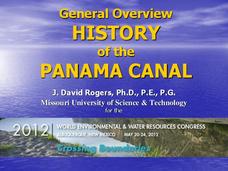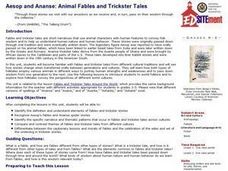Constitutional Rights Foundation
The Cold War: How Did It Start? How Did It End?
What is the difference between a Cold War and a Hot War? Scholars research the beginning of the Cold War. They analyze diary entries as well as excerpts from various events during the 45-year standoff. To finish, they prepare final...
Reed Novel Studies
Elijah of Buxton: Novel Study
Most think Elijah in Elijah of Buxton by Christopher Paul Curtis gets famous for being the first African American child born free from slavery. However, his true fame comes from his adventures to capture a thief. Readers study Elijah's...
Curated OER
Constitutional Amendments and Gay Marriage
High schoolers study the legal battles involving same-sex marriage. They examine primary sources and a video regarding the 14th amendment and its implications for gay marriage. They analyze a report of a California case that was sent to...
Teach With Movies
Learning Guide for: Glory
Invite your class to learn about the first regular US army unit composed of black soldiers during the Civil War with the film Glory. This website reviews the historical accuracy of the movie, offers pre- and post-viewing handouts, and...
Teach With Movies
Learning Guide To: Gone with the Wind
The film version of Gone with the Wind is the focus of this learning guide that asks viewers to consider some of the issues that the Southern states faced prior to and during the Civil War.
Civil Rights Movement Veterans
Timeline of Events: 1960’s Civil Rights Movement of St. Augustine, Florida
A timeline can be a powerful learning tool because it reveals a pattern in events. While few would consider St. Augustine, Florida a hotbed of the 1960s Civil Rights Movement, a selection of background information and a timeline of...
Texas State Energy Conservation Office
Global Climate Change
Here is an extensive reading resource that addresses our climate change crisis. It thoroughly explains the greenhouse effect, related Earth cycles, and the history of climate change. Use it as part of the intended unit, published by the...
National Endowment for the Humanities
Factory vs. Plantation in the North and South
North is to factory as South is to plantation—the perfect analogy for the economy that set up the Civil War! The first lesson plan in a series of five helps teach beginners why the economy creates a driving force for conflict. Analysis...
Curated OER
Photography and the National Park Service
During the 1800s the United States was expanding westward; land was there for the taking. Kids explore how some early photographers used their photography to influenced the US Congress to save areas like Mirror Lake. They complete a...
Global Oneness Project
Flamenco: A Cross-Cultural Art Form
Notes of pride and persecution, exclusion and isolation resonate in flamenco. Introduce this musical art form to your social studies or Spanish language classes with a resource that follows a young flamenco guitarist as he practices his...
Alabama Department of Archives and History
Two Different African-American Visions: W.E.B. Du Bois and Booker T. Washington
The strategies civil rights activists Booker T. Washington and W.E.B. Du Bois proposed for blacks to achieve racial progress is the focus of an activity in which class groups identify the strategies as well as the benefits and drawbacks...
Missouri University of science & Technology
General Overview History of the Panama Canal
Called the Eight Wonder of the World by some and the Big Ditch by others, the Panama Canal is indeed an engineering marvel. The long, complicated, and sometimes controversial history of the canal is captured in a presentation loaded with...
Curated OER
Aesop and Ananse: Animal Fables and Trickster Tales
Students complete compare and contrast activities dealing with fables and trickster tales to determine how each uses animals to portray human characteristics, specifically strengths and weaknesses, as well as pass wisdom from one...
National Endowment for the Humanities
Women's Lives Before the Civil War
Women's lifestyles before the Civil War made a huge impact as a point of causation. Give middle schoolers the opportunity to view firsthand the lives of women before the Civil War. They analyze primary source documents, view photographs,...
Curated OER
Washington Irving in Context
Students examine the various roles Washington Irving had in his lifetime. Examining the situation in Europe and the United States, they are encouraged to relate Irving's experiences to different events. They examine themselves in many...
Curated OER
In the Courts
Students explore desegregation in the courts. In this civil rights lesson, students listen to their instructor present a lecture on Supreme Court cases Brown v. Board of Education and Plessy v. Ferguson. Students examine the cases and...
Curated OER
National Home for Disabled Volunteer Soldiers i
Students explore the challenges involved in carrying out a program to care for the needs of Civil War veterans an to mark their graves after their deaths. The biography of a veteran from the community is researched and written in this...
Curated OER
A Differentiated Way through Think Dots
Learners examine reasons that led people to explore, identify "West" as defined following Revolutionary War, explain importance of finding natural resources, develop time line of dates and events leading up to Lewis and Clark Expedition,...
Curated OER
America's Wars, 1898-1945
High schoolers examine the wars the United States was involved in between 1898 and 1945. In groups, they determine the causes and effects of each war and how each war changed the way the United States handled their foreign affairs. As a...
Curated OER
Meet the Underground Railroad
Students research and learn about the Underground Railroad. In this Underground Railroad lesson plan, students take 2 weeks to research an individual, complete journal writings, read passages in small groups, list major events, and more.
Curated OER
Expansion and Reform: Applying the Declaration of Independence
Students conduct inquiries and research-acquiring, organizing, analyzing, interpreting, evaluating, and communicating facts, themes, and general principles operating in American history. They use the Declaration of Independence to...
Curated OER
What is Government?
Students explore values that unite Americans. In this government instructional activity, students recall the symbols of America and discuss how to create a "Classroom Constitution." Students form rules and write their own Constitution.
Curated OER
Cartoons for the Classroom: Xenophobia
For this historical events worksheet, students analyze an anti-immigration political cartoon and respond to 3 talking point questions.
Curated OER
Pioneer America: Journey West
Fourth graders experience pioneer life on the Oregon trail. In this pioneer lesson, 4th graders research the reasons for moving west and what life was like on the trail. They create a map, complete an oral presentation, and write about...

























